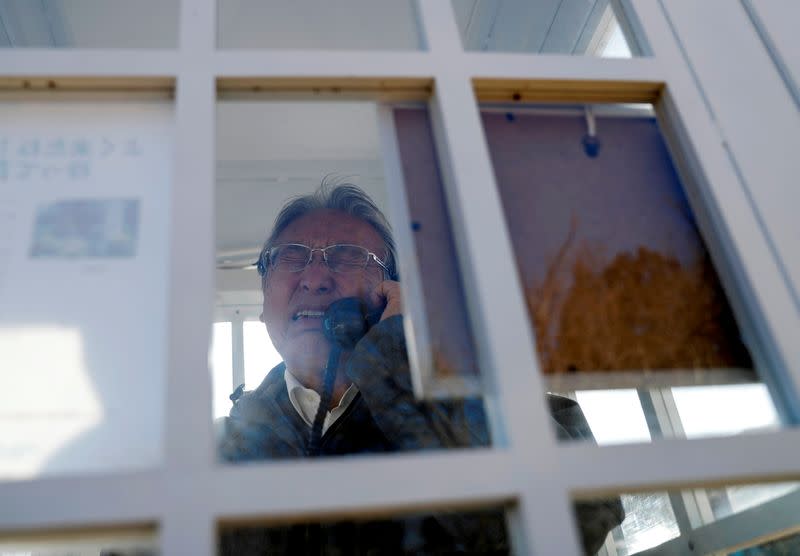By Mari Saito
OTSUCHI, Japan (Reuters) – In a garden on a hill, under the broad branches of a cherry tree, a white telephone booth glows in the early spring light.
Inside, Kazuyoshi Sasaki carefully dials the cell phone number of his late wife Miwako, folding his large body and holding the phone.
He explains how he sought her out for days after the devastating earthquake and tsunami of a decade ago, visiting evacuation centers and makeshift morgues, returning at night to the rubble of his home.
“It all happened in an instant, I can’t forget it now,” he says, crying. “I texted saying where I was, but you didn’t check.”
“When I came home and looked at the sky, there were thousands of stars, it was like looking at a jewelry box,” said the 67-year-old man. “I cried and cried and knew then that many people must have died.”
Sasaki’s wife was one of nearly 20,000 people killed in northeastern Japan in the March 11, 2011, disaster.
Many survivors say that the disconnected phone line in the city of Otsuchi helps them keep in touch with their loved ones and gives them some comfort as they struggle with their pain.
I’M LONELY
Earlier, Sachiko Okawa calls Toichiro, her late husband, with whom she has been married for 44 years. She asks what he has been doing since he was dragged by the tsunami a decade ago.
“I’m alone,” she says finally, in a choked voice, and asks Toichiro to take care of the family. “Bye for now, I’ll be back soon.”
Okawa says he sometimes feels that he can hear Toichiro on the other end of the line.
“It makes me feel a little better.”
The 76-year-old lady, who learned about the hillside garden from friends, usually brings her two grandchildren here so they can also talk to her grandfather.
“Grandpa, it’s been 10 years and I’ll be in high school soon,” says Daina, Okawa’s 12-year-old grandson, while everyone squeezes into the phone booth. “There is a new virus that is killing a lot of people and that is why we wear masks. But we are all well.”
WIND PHONE
The phone booth was built by Itaru Sasaki, who owns the garden in Otsuchi, a city about 500 km northeast of Tokyo, a few months before the disaster, after he lost his cousin to cancer.
“There are a lot of people who were unable to say goodbye,” he says. “There are families who would have liked to have said something at the end, if they knew they would not speak again.”
The phone now attracts thousands of visitors from all over Japan. It is not only used by tsunami survivors, but also by people who have lost relatives due to illness and suicide. Dubbed “the phone of the wind”, it recently inspired a film.
A few months ago, Sasaki said he was approached by organizers who want to establish similar phones in Britain and Poland, which would allow people to call relatives who lost in the coronavirus pandemic.
“Just like a disaster, the pandemic came suddenly and, when death is sudden, the grief that the family experiences is also much greater,” says the 76-year-old man.
I’m so glad we met
Like thousands of others in devastated coastal communities, Kazuyoshi Sasaki, the councilor, lost not only his wife, but many other relatives and friends in the disaster.
He knew and loved Miwako for most of his life.
He confessed his love for her for the first time when they were both in elementary school, an offer that she promptly rejected. It took another 10 years for the two to start dating. Eventually, they got married and had four children.
Sasaki explains to his wife that he recently left temporary housing and that his youngest son is building a new home where he can live with his grandchildren.
Before hanging up, Sasaki told Miwako that a recent health check showed he had lost weight.
“I’ll take care of myself,” he promises her as a strong wind blows outside. “I am so happy that we met, thank you, we are all doing what we can, talk soon.”
(Reporting by Mari Saito and Issei Kato; Editing by Pravin Char)
